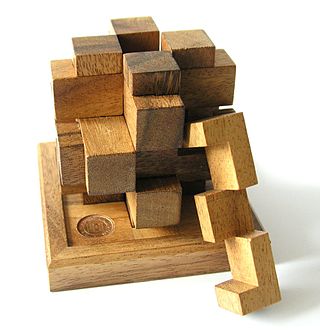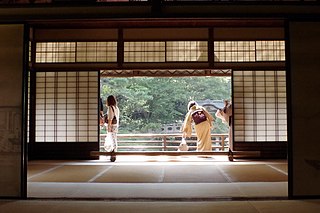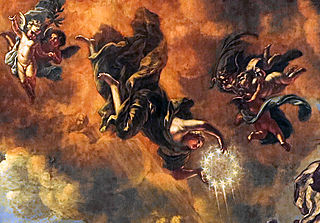Related Research Articles

Woodworking is the skill of making items from wood, and includes cabinetry, furniture making, wood carving, joinery, carpentry, and woodturning.

A jigsaw puzzle is a tiling puzzle that requires the assembly of often irregularly shaped interlocking and mosaicked pieces, each of which typically has a portion of a picture. When assembled, the puzzle pieces produce a complete picture.

Carpentry is a skilled trade and a craft in which the primary work performed is the cutting, shaping and installation of building materials during the construction of buildings, ships, timber bridges, concrete formwork, etc. Carpenters traditionally worked with natural wood and did rougher work such as framing, but today many other materials are also used and sometimes the finer trades of cabinetmaking and furniture building are considered carpentry. In the United States, 98.5% of carpenters are male, and it was the fourth most male-dominated occupation in the country in 1999. In 2006 in the United States, there were about 1.5 million carpentry positions. Carpenters are usually the first tradesmen on a job and the last to leave. Carpenters normally framed post-and-beam buildings until the end of the 19th century; now this old-fashioned carpentry is called timber framing. Carpenters learn this trade by being employed through an apprenticeship training—normally four years—and qualify by successfully completing that country's competence test in places such as the United Kingdom, the United States, Canada, Switzerland, Australia and South Africa. It is also common that the skill can be learned by gaining work experience other than a formal training program, which may be the case in many places.

A mechanical puzzle is a puzzle presented as a set of mechanically interlinked pieces in which the solution is to manipulate the whole object or parts of it. While puzzles of this type have been in use by humanity as early as the 3rd century BC, one of the most well-known mechanical puzzles of modern day is the Rubik's Cube, invented by the Hungarian architect Ernő Rubik in 1974. The puzzles are typically designed for a single player, where the goal is for the player to discover the principle of the object, rather than accidentally coming up with the right solution through trial and error. With this in mind, they are often used as an intelligence test or in problem solving training.

Wood carving is a form of woodworking by means of a cutting tool (knife) in one hand or a chisel by two hands or with one hand on a chisel and one hand on a mallet, resulting in a wooden figure or figurine, or in the sculptural ornamentation of a wooden object. The phrase may also refer to the finished product, from individual sculptures to hand-worked mouldings composing part of a tracery.

A minbar is a pulpit in a mosque where the imam stands to deliver sermons. It is also used in other similar contexts, such as in a Hussainiya where the speaker sits and lectures the congregation.

A dovetail joint or simply dovetail is a joinery technique most commonly used in woodworking joinery (carpentry), including furniture, cabinets, log buildings, and traditional timber framing. Noted for its resistance to being pulled apart, also known as tensile strength, the dovetail joint is commonly used to join the sides of a drawer to the front. A series of pins cut to extend from the end of one board interlock with a series of 'tails' cut into the end of another board. The pins and tails have a trapezoidal shape. Once glued, a wooden dovetail joint requires no mechanical fasteners.

According to the New Testament, a woven crown of thorns was placed on the head of Jesus during the events leading up to his crucifixion. It was one of the instruments of the Passion, employed by Jesus' captors both to cause him pain and to mock his claim of authority. It is mentioned in the gospels of Matthew, Mark and John, and is often alluded to by the early Church Fathers, such as Clement of Alexandria, Origen and others, along with being referenced in the apocryphal Gospel of Peter.

A shoji is a door, window or room divider used in traditional Japanese architecture, consisting of translucent sheets on a lattice frame. Where light transmission is not needed, the similar but opaque fusuma is used. Shoji usually slide, but may occasionally be hung or hinged, especially in more rustic styles.
A circlet is a piece of headwear that is similar to a diadem or a corolla. The word 'circlet' is also used to refer to the base of a crown or a coronet, with or without a cap. Diadem and circlet are often used interchangeably, and 'open crowns' with no arches have also been referred to as circlets. In Greek this is known as stephanos, and in Latin as corona aperta, although stephanos is associated more with laurel wreaths and the crown of thorns said to have been placed on the head of Jesus.

A box joint is a woodworking joint made by cutting a set of complementary, interlocking profiles in two pieces of wood, which are then joined (usually) at right angles, usually glued. The glued box joint has a high glued surface area resulting in a strong bond, on a similar principle to a finger joint. Box joints are used for corners of boxes or box-like constructions, hence the name. The joint does not have the same interlocking properties as a dovetail joint, but is much simpler to make, and can be mass-produced fairly easily.
Crown of thorns was worn by Jesus of Nazareth during the Passion.
This glossary of woodworking lists a number of specialized terms and concepts used in woodworking, carpentry, and related disciplines.

The Crown of Immortality is a literary and religious metaphor traditionally represented in art first as a laurel wreath and later as a symbolic circle of stars. The Crown appears in a number of Baroque iconographic and allegoric works of art to indicate the wearer's immortality.
Stewart Coffin is an American puzzle maker. According to Ars Technica, he is considered to be one of the "best designers of polyhedral interlocking puzzles in the world."
Tramp art is a style of woodworking which emerged in America in the latter half of the 19th century. Some of tramp art's defining characteristics include chip or notch carving, the reclamation of cheap or available wood such as that from cigar boxes and shipping crates, the use of simple tools such as penknives, and the layering of materials into geometric shapes through glue or nails. One technique used in tramp art is Crown of Thorns joinery.

The conservation and restoration of wooden artifacts refers to the preservation of art and artifacts made of wood. Conservation and restoration in regards to cultural heritage is completed by a conservator-restorer.

The Minbar of the al-Aqsa Mosque, also known as the Minbar of Saladin, was a notable historic minbar inside the al-Aqsa Mosque in Jerusalem. It was originally commissioned by Nur al-Din in 1168-69 CE in Aleppo, Syria and was later moved to Jerusalem after the city was conquered in 1187 by Salah ad-Din (Saladin). It was one of the most famous historic minbars of the Muslim world and was considered by scholars to be a highly significant object of medieval Islamic art.

Kumiko is a Japanese technique of assembling wooden pieces without the use of nails.

In Mandaeism, the klila is a small myrtle wreath or ring used during Mandaean religious rituals. The klila is a female symbol that complements the taga, a white crown which always takes on masculine symbolism.
References
- ↑ Harding, Deborah, and Laura Fisher. Home Sweet Home: The House in American Folk Art. New York: Rizzoli, 2001. Print.
- ↑ Toni Mortimer Gilroy, "Cigar boxes recycled into tramp art" Antiqueweek.com 1/11/2008 accessed 4/16/2014